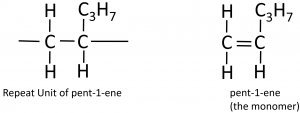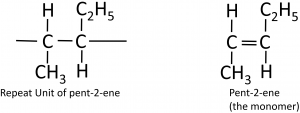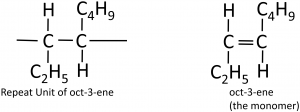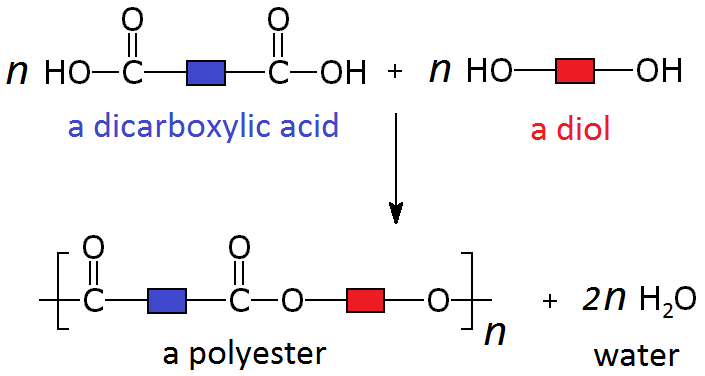4:44 know that an addition polymer is formed by joining up many small molecules called monomers

Monomers join together to form a long chain.
Polymer contains only single bonds.

Monomers join together to form a long chain.
Polymer contains only single bonds.
To deduce the structure of the monomer from a repeat unit:



Here’s a more complicated example, going from the polymer to the structure of the monomer
Polymers are inert (unreactive) as they have strong C-C bonds.
This makes them non-biodegradeable.
Biodegradable: the breakdown of a substance by microorganisms.
if burnt the addition polymers could produce toxic gases such as carbon monoxide and hydrogen chloride.
Condensation polymers are formed by a condensation reaction.
These polymers are formed by the combination of two different monomers, such as a dicarboxylic acid and a diol.
When these particular monomers join in an alternating pattern they form a long polymer called a polyester. Where each monomer joins to the next, a separate molecule of water is also produced.
Polyesters are polymers formed when two types of monomer join together alternately. Where each joins to the next a small molecule, such as water or hydrogen chloride, is lost. This is called a condensation polymerisation reaction.
One of the monomers is a diol, an alcohol with a -OH functional group at each end. An example is hexane-1,6-diol which has the structural formula CH₂OHCH₂CH₂CH₂CH₂CH₂OH and the displayed formula:

Since it is only the -OH functional groups which are important for polymerisation, this can we re-written with the central block of carbons represented as a block:
![]()
The other monomer is a dicarboxylic acid, a molecule with a -COOH functional group at each end. An example is hexane-1,6-dioic acid which has the structural formula HOOCCH₂CH₂CH₂CH₂COOH and the displayed formula:

Since it is only the -COOH functional groups which are important for polymerisation, this can we re-written with the central block of 4 carbons represented as a block:

These two different types of monomer (the diol and the dicarboxylic acid) can join to form a polymer with the loss of a water molecule at every bond. As above, this can be simplified by only looking at the functional groups and representing the other carbons as blocks, so the whole process looks like:

A simple example of this is the condensation polymerisation reaction between ethanedioic acid and ethandiol:

There are environmental issues with the disposal of condensation polymers, though because of their ester linkage the issues are not as severe as with addition polymers. Normally condensation polymers can take hundreds of years to break down, but chemists has developed biopolyesters which break down much more quickly.